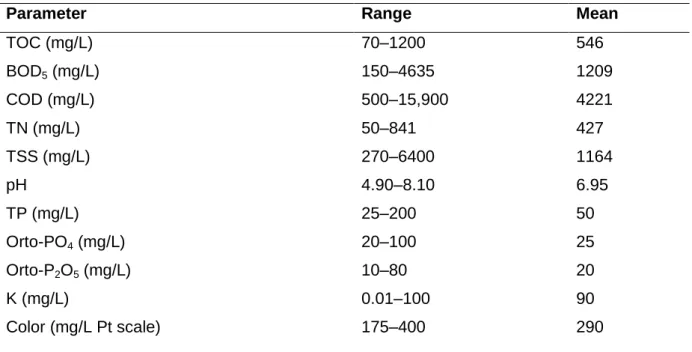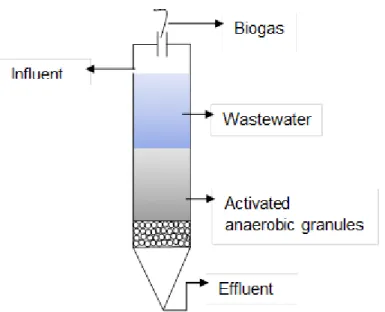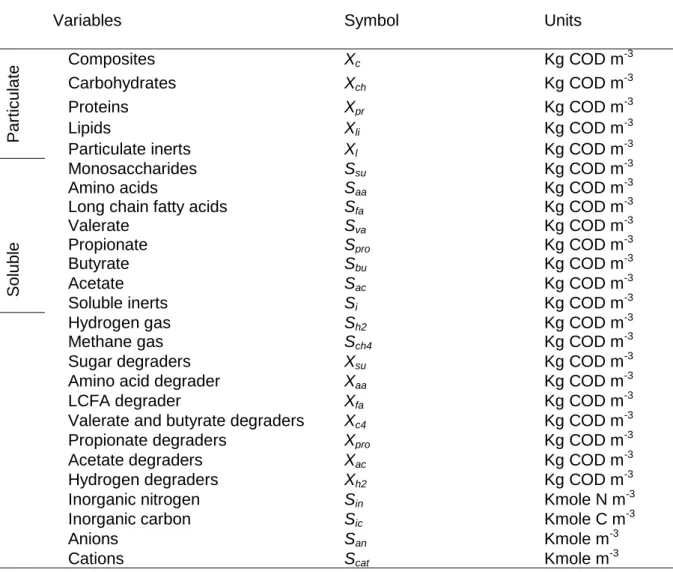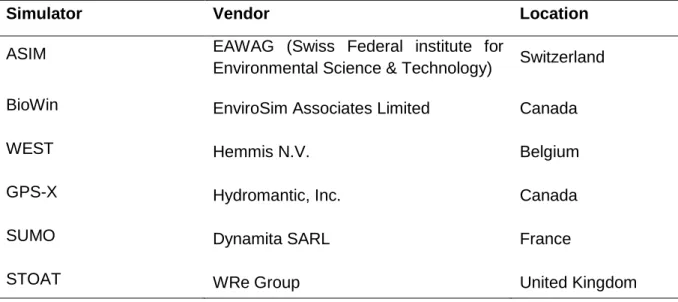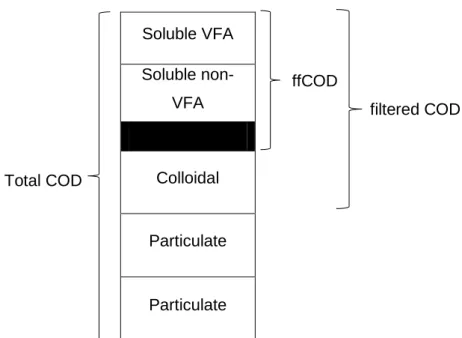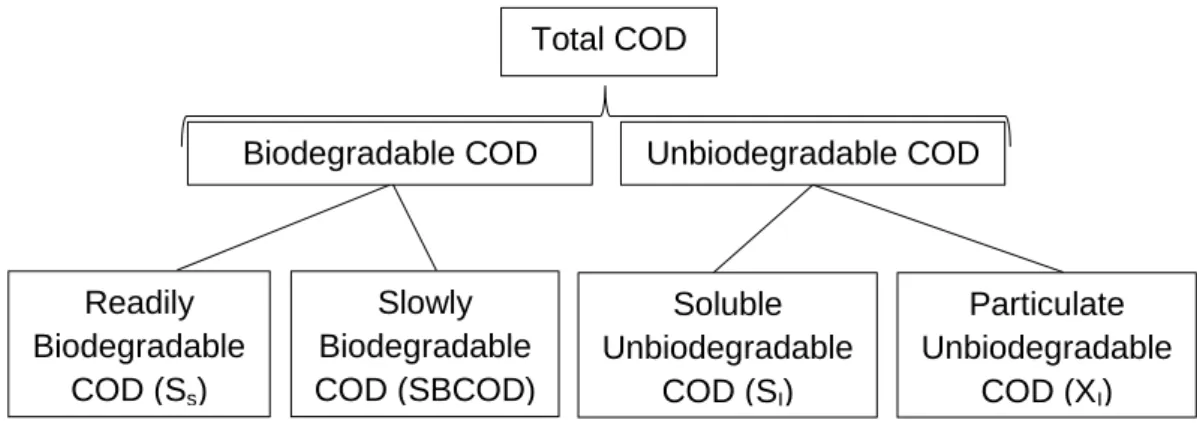With the help of Sumo, two models were designed in this study, namely a single and a two-stage anaerobic digestion without a recycle. The digester for the single-stage anaerobic digestion system modeled was set to operate at steady state for 150 days under mesophilic temperature (35˚C) with a solids retention time (SRT) of 25 days. The two-stage anaerobic digestion showed better performance compared to the single-stage anaerobic digestion system.
Background
Research problem statement
Research questions
Research aim and objectives
Significance of the research
Delineation of the research
Characteristic of poultry slaughterhouse wastewater
Regulations governing discharge of poultry slaughterhouse wastewater in South
Vw = total volume (kL) of waste water discharged from the premises during the assessed period. Vie = total volume (kL) of industrial wastewater discharged from the premises in the assessed period. X = concentration of one or more of the parameters listed in schedule 2 (see table 2.2), and L = is the limit value for the parameter in question.
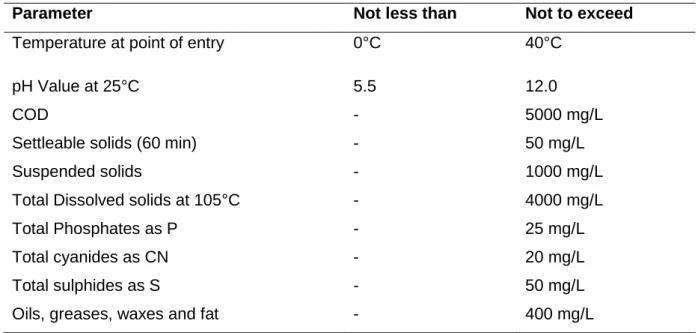
Poultry slaughterhouse wastewater treatment
Environmental impact and health effects of slaughterhouse wastewater
Anaerobic wastewater treatment of PSW
Stages of anaerobic digestion
Among these technologies, anaerobic treatment has gained momentum due to its favorable operational outcomes such as high concentration organic matter removal, high pathogen removal, low sludge production, biogas production and low energy consumption, with a low plant footprint. After the acidogenesis phase is the acetogenesis phase, whereby bacteria convert acids and alcohols into acetate, hydrogen and CO2. Methanogenesis is a critical stage, in the whole anaerobic digestion process, because it is the slowest biochemical reaction of the process (Muha, 2013).
Assessment of technologies performed in the treatment of poultry slaughterhouse
Up flow anaerobic sludge blanket (UASB) technology
The UASB technology was newly introduced in the late 1970s by Lettinga and his associates and first applied by the Dutch sugar industry. Currently, the reactor is widely used to treat various types of waste water, and therefore forms part of high-rate anaerobic technology bioreactors. A major advantage of the technology is its cost effectiveness compared to an anaerobic filter.
Furthermore, its workability relies on sufficient amounts of crushed seed slurry for a quick start (Rajeshwari et al., 2000). After the reactor is seeded with anaerobic sludge, the wastewater is made to flow upward through the sludge blanket. The appearance of this phenomenon depends greatly on the suitable conditions of organic matter in the wastewater and the availability of nutrients, COD, pH, alkalinity,.
Granule size can range from 0.1 to 5 mm, with higher upflow velocity providing higher shear forces, resulting in very compact granules (Figure 2.2). According to Sivagurunathan et al. 2006), the upper layer of the dense mud layer consists of a mud blanket zone with highly diverse growth and lower particle settling velocities. 2006) also pointed out that in the UASB the biological reaction takes place between the highly active mud and the blanket zone. As the wastewater moves upward, anaerobic bacteria convert the organic material into biogas, consisting primarily of CH4 and CO2.
The primary function of gas-liquid solids (GLS) separators is to separate solids from sludge/solids, including biogas, while baffles retain viable bacterial matter in place by pushing settled solids back into the reaction zone, increasing sustainability bioreactor. during longer operating periods.
Static Granular Bed Reactor (SGBR)
As the influent wastewater enters the SGBR reactor, it pneumatically mixes with the bulk liquid via counter-directional movement of biogas and the liquid being treated so that a high concentration of organic matter in the influent is evenly distributed within the sludge. SGBR also acts as an anaerobic bio-filter as it involves no mixing systems and has stable granules that trap solids entering the bioreactor (Del Nery et al., 2001). The effluent produced as a result has a low residual concentration of COD, TSS and volatile acids (VAs) which in some cases may allow it to be discharged to surface water without additional treatment; in other words, the effluent released by the system routinely meets a 30 mg/L BOD5 and 30 mg/L TSS effluent standard limit (Evans, 2004).
Expanded granular sludge bed (EGSB)
The reactor is in fact a vertically stretched version of the UASB reactor with a height of 12-16m with a loading capacity of 15-25 kg COD/m3.day, resulting in an even more reduced plant footprint (Del Nery et al., 2001). The EGSB, like the UASB reactor, separates the biomass, biogas and wastewater in a single step using three-phase separators at the top of the reactor. 2016) after using the EGSB to treat poultry wastewater reported periodic sludge from the system.
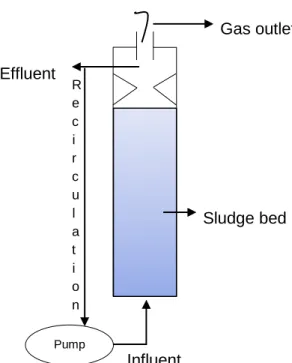
Introduction
Model description
ADM1 is an organized generic model depicting the main process describing the biochemical and physico-chemical processes involved in the breakdown of complex organic compounds into biogas and inert by-products (Batstone et al., 2012). ADM1 is a mathematical model based on COD as a general unit used in waste water characterization and representing the performance of organic substrate removal (Boubaker and Ridha, 2008). The organic components considered by the model are as follows: complex particles, proteins, carbohydrates, sugars, lipids, amino acids (AA), long-chain fatty acids (LCFA), volatile fatty acids, and particulate and soluble inert substrates (Karakashev et al., 2006).
The first biochemical conversion in digesters involves the breakdown of complex particles into monomer components of proteins, carbohydrates, lipids, particles and some soluble inert substrates. Hydrolysis of particulate monomers is the next conversion step where carbohydrates, proteins and lipids are converted into sugars, amino acids (AA) and long chain fatty acids (LCFA) by hydrolytic bacterial species. Once particulate monomers are hydrolysed, fermentation of AA follows to produce CO2, hydrogen and AA (acidogenesis) (Derbal et al., 2009).
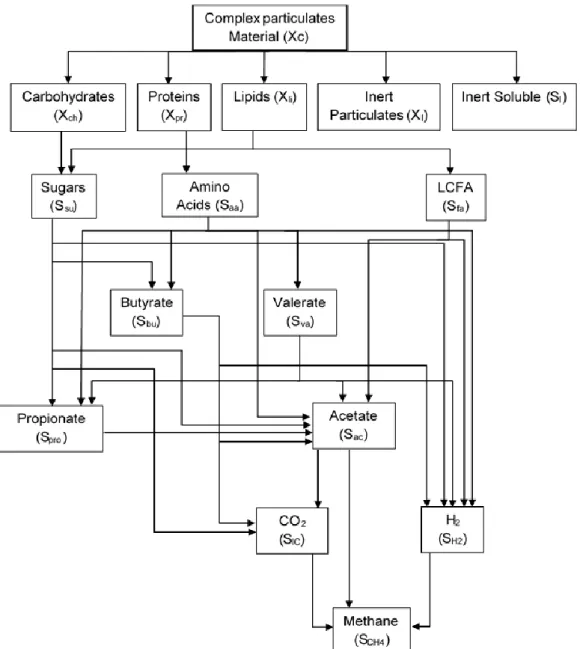
Model equations
Liquid phase equations
The mass balance equations used by the ADM1 model to describe the dynamic behavior of soluble and particulate substrates in the liquid phase are shown in Eq.
Gas phase equations
When assessing the dynamic gas phase concentration of all gas components, assuming that the total pressure of the gas phase is above that of the liquid, is below specified reactor temperature.
Simulator versus biological model
SUMO simulator
Introduction
Fractionation of COD
Quantification of COD
Total COD = Ss + Scol + Xs + SI + XI (4.3) Filtered COD was determined by passing a PWS sample through a 1.0 µm glass fiber filter (Figure 4.3) and measuring the COD of the filtrate using a test kit COD Merck, which includes the methods as stated in the manual produced. Filtered flocculated COD (ffCOD) was determined by PSW flocculation followed by a filtration process as suggested by Mamais et al. The flocculation step involves adding 1 mL of zinc sulfate (ZnSO4) to 100 mL of PSW after vigorous mixing for one minute.
6M sodium hydroxide was added to the solution to adjust the pH to 10.5 and allow the waste water to settle for a few minutes. The filtration step involves filtering the supernatant from the flocculated samples with a 0.22 µm membrane filter instead of 0.45 µm filters. The use of the chemical flocculant with filtration is intended to remove colloidal COD (Scol) (Mamais et al., 1993).
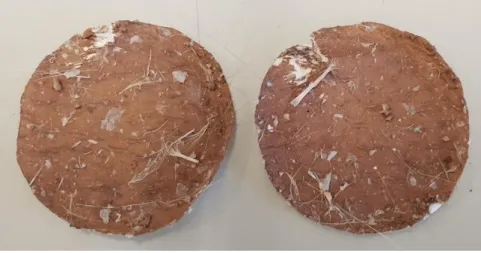
Introduction
Phase 1: Poultry wastewater treatment digester configuration
Single stage digestion
The inhibiting factors include insufficient trace elements and excessive macronutrients that can lead to digestive failure due to acidification (Mao et al., 2015). The digester in the single-phase anaerobic digestion system designed was set to operate at steady state for 150 days under mesophilic temperature (35 ˚C) with a solids retention time (SRT) of 25 days (Figure 5.1).
Two stage digestion
When it comes to a two-stage anaerobic digestion and/or multi-stage anaerobic digestion, terms such as "batch mesophilic digestion, acid phase digestion and temperature phased anaerobic digestion (TPAD)" are usually used to describe such processes. In series mesophilic digestion, two or more mesophilic digesters operate in series at a sufficient SRT in the first stage to provide suitable methanogenesis conditions in the second or tertiary stage. In a TPAD process, the production of biosolids by operating the first stage thermophilic (50 to 60°C) followed by a mesophilic digester can result in higher biogas production and digester performance.
This anaerobic digestion system has also been suggested as a means to improve digestion capacity through high-rate thermophilic kinetics. Regarding acid-phase digestion, a short first phase SRT with low pH (5.5 to 6.5) is required to mainly favor the hydrolysis and fermentation of solids. This is followed by a longer SRT in the second stage at a higher pH (7 to 8) for further hydrolysis and fermentation, i.e.
The two-stage digestion system designed for poultry slaughterhouse wastewater in this study was of acid-phase digestion type. Both digesters were set to operate at mesophilic temperature (35 ˚C) at SRT of 13 days in the first digester and 25 days in the second digester. The two-stage anaerobic digestion showed better performance compared to the single-stage anaerobic digestion.
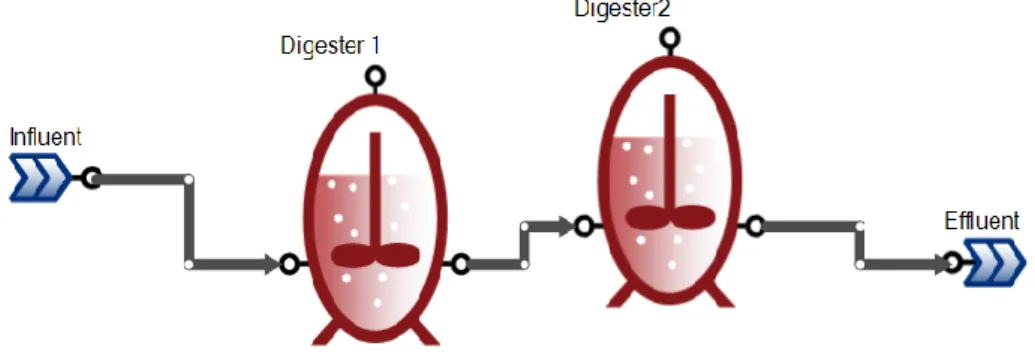
Phase 2: Assessment the performance of the designed model in treating poultry
- PSW characterization
- Performance of the single stage anaerobic digestion
- Performance of the two-stage anaerobic digestion
- Biogas production during PSW treatment
- Comparison of the two designs
The used model requires the influential parameters of wastewater characterization, such as TSS, VSS, TKN, TP, alkalinity, pH, BOD5, total COD and COD fractions. The COD/BOD ratio was also calculated to assess the potential biodegradability of the organic content in PSW. The wastewater characteristics used in this study are similar to the PSW characteristics reported in other studies by Basitere et al.
The single-stage anaerobic digester was used as the primary treatment step for reducing organic matter and suspended solids from PSW before undergoing further treatment, i.e. as expected, negligible variations in nutrient removal were observed during the 150 days of single-stage anaerobic digestion. . The accumulation of phosphate and ammonia was observed to be minutely higher than a single stage digester.
Biogas produced by anaerobic digestion consists mainly of methane CH4 and carbon dioxide (CO2). In the event that the biogas contains a high concentration of oxygen, this could be justified by air penetration through the upper part of the digester or through a water displacement system. This is not quantified in the model; therefore, it is important to ensure that the digester remains completely closed during anaerobic digestion.
Although the performance of two-stage anaerobic digestion for the treatment of PSW showed excellent performance compared to single-stage anaerobic digestion, it was observed that the performance of the two designs was not much differentiated - see Table 5.4, although configuration R2 demonstrated a higher biogas production capacity.

Conclusion
